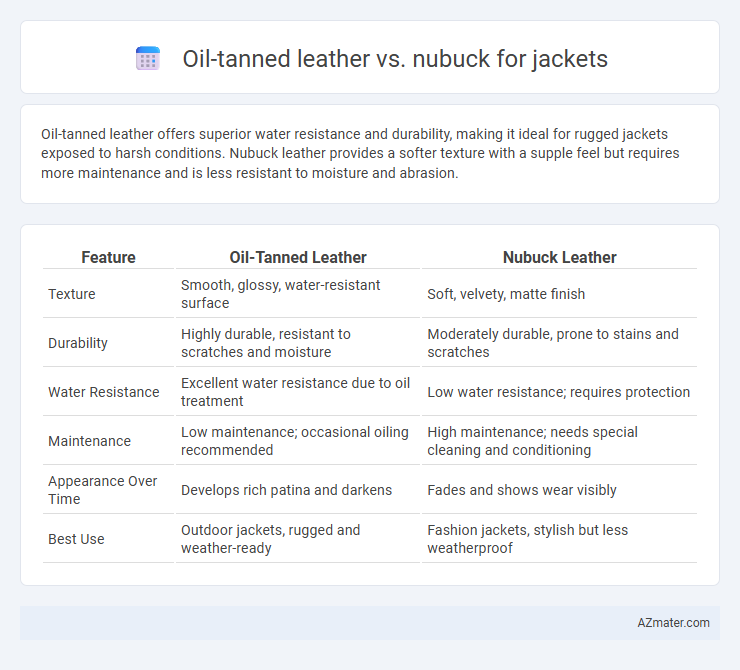Oil-tanned leather offers superior water resistance and durability, making it ideal for rugged jackets exposed to harsh conditions. Nubuck leather provides a softer texture with a supple feel but requires more maintenance and is less resistant to moisture and abrasion.
Table of Comparison
| Feature | Oil-Tanned Leather | Nubuck Leather |
|---|---|---|
| Texture | Smooth, glossy, water-resistant surface | Soft, velvety, matte finish |
| Durability | Highly durable, resistant to scratches and moisture | Moderately durable, prone to stains and scratches |
| Water Resistance | Excellent water resistance due to oil treatment | Low water resistance; requires protection |
| Maintenance | Low maintenance; occasional oiling recommended | High maintenance; needs special cleaning and conditioning |
| Appearance Over Time | Develops rich patina and darkens | Fades and shows wear visibly |
| Best Use | Outdoor jackets, rugged and weather-ready | Fashion jackets, stylish but less weatherproof |
Introduction to Oil-Tanned Leather and Nubuck
Oil-tanned leather is a durable, water-resistant material treated with oils during tanning, resulting in a rich, supple texture that improves with age and develops a unique patina over time. Nubuck is a type of top-grain leather that is sanded or buffed on the grain side to create a soft, velvety surface with a distinctive matte finish, offering a luxurious feel but requiring more maintenance and protection from stains. Both materials are popular for jackets, with oil-tanned leather favored for its rugged durability and weather-resistant properties, while nubuck is chosen for its elegant appearance and soft texture.
Key Differences Between Oil-Tanned Leather and Nubuck
Oil-tanned leather features a durable, water-resistant surface with a rich, glossy finish due to the infusion of oils during tanning, making it highly resistant to wear and ideal for rugged jackets. Nubuck, on the other hand, is a top-grain leather buffed to create a soft, velvety texture that offers a matte appearance but requires more care to maintain its delicate finish and resist stains. The key differences lie in texture, durability, water resistance, and maintenance, with oil-tanned leather suited for heavy-duty use and nubuck favored for its luxurious softness and aesthetic appeal.
Durability: Which Material Lasts Longer?
Oil-tanned leather offers superior durability due to its dense fibrous structure and water-resistant finish, making it highly resistant to scratches, stains, and general wear over time. Nubuck, while luxurious and soft with a velvety texture, is more susceptible to damage from moisture and abrasions, which can reduce its lifespan in high-use conditions. For long-lasting jackets, oil-tanned leather is the preferred choice where rugged durability and extended wear are essential.
Appearance and Texture Comparison
Oil-tanned leather features a smooth, slightly glossy finish with a rich, deep color that enhances with age, offering a rugged yet polished appearance ideal for jackets. Nubuck has a soft, velvety texture with a matte, suede-like surface that provides a more casual and delicate look, susceptible to showing stains and wear more easily. Both materials offer unique tactile experiences, with oil-tanned leather feeling firmer and more durable, while nubuck presents a plush, comfortable touch.
Water and Stain Resistance
Oil-tanned leather offers superior water and stain resistance due to its dense, waxy finish that repels moisture and dirt effectively, making it ideal for rugged, all-weather jackets. Nubuck leather, while soft and breathable with a velvety texture, is more porous and susceptible to water absorption and staining, often requiring additional protective treatments or sprays. For long-lasting durability in wet or dirty conditions, oil-tanned leather jackets provide a practical advantage over nubuck.
Comfort and Wearability
Oil-tanned leather offers exceptional durability and water resistance, making jackets highly suitable for outdoor use while providing a firm yet flexible comfort. Nubuck, with its soft, velvety texture derived from sanding the outer layer of hide, delivers a gentle, breathable feel ideal for moderate climates, although it requires more care to maintain its appearance. Both materials provide unique comfort levels and wearability, with oil-tanned leather better suited for rugged wear and nubuck excelling in lightweight, stylish jackets.
Maintenance and Care Tips
Oil-tanned leather jackets require regular application of leather conditioner to maintain their rich texture and prevent drying or cracking, while avoiding excessive water exposure preserves their durability. Nubuck jackets need gentle brushing with a suede brush to remove dirt and restore the nap, and applying a specialized nubuck protector helps resist stains and moisture. Both materials benefit from storage in a cool, dry place away from direct sunlight to prevent fading and structural damage.
Price Comparison: Oil-Tanned Leather vs Nubuck
Oil-tanned leather jackets typically cost more due to the intensive tanning process that enhances durability and water resistance, often ranging from $250 to $600. Nubuck jackets, being softer and more delicate, generally fall into a lower price bracket, averaging between $150 and $400. Price differences reflect the distinct manufacturing methods and expected wear performance of oil-tanned leather versus nubuck.
Best Uses for Jackets: Style Recommendations
Oil-tanned leather is best suited for rugged, outdoor jackets due to its durable, water-resistant finish and rich, natural patina that deepens with wear. Nubuck leather offers a softer, velvety texture ideal for casual or fashion-forward jackets, providing a refined, matte appearance that pairs well with smart-casual outfits. For style recommendations, choose oil-tanned leather jackets for versatile, long-lasting outerwear that ages beautifully, while nubuck jackets are perfect for a polished look that balances comfort and sophistication.
Choosing the Right Material for Your Leather Jacket
Oil-tanned leather offers exceptional durability and water resistance, making it ideal for rugged, long-lasting jackets that handle outdoor conditions. Nubuck provides a softer, velvety texture with a luxurious feel, suited for stylish, casual wear but requires more care to maintain its appearance. Choosing between oil-tanned leather and nubuck depends on whether you prioritize toughness and weather protection or a sophisticated, softer finish for your leather jacket.

Infographic: Oil-tanned leather vs Nubuck for Jacket
 azmater.com
azmater.com